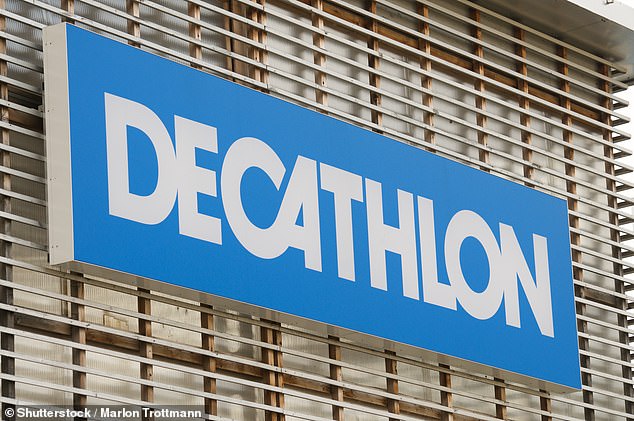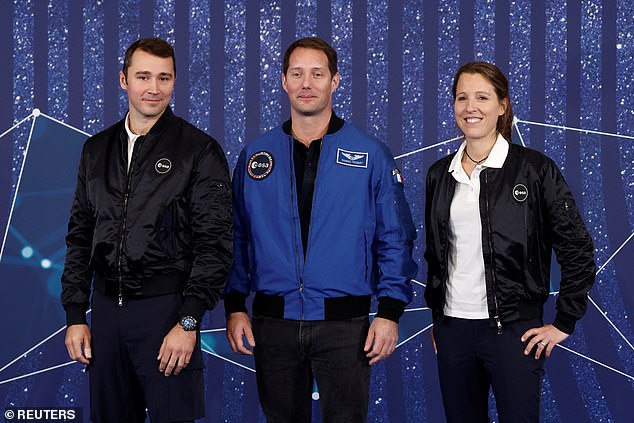For decades, the USA and Europe have been battling it out in the space race.
But when it comes to high fashion, there’s now a clear winner.
While NASA‘s spacesuits are being developed, in part, by Prada, astronauts at the European Space Agency (ESA) will have to settle for a more humble designer – Decathlon.
The high street brand, best known for selling affordable sportswear, has announced it is behind a new intra-vehicular activity (IVA) space suit prototype.
Its dark grey ‘EuroSuit’ is designed to be worn during ‘critical’ phases of a mission, such as launch and landing, and can be donned or removed without assistance in under two minutes.
It will be tested by ESA astronaut Sophie Adenot during a mission to the International Space Station (ISS) next year.
The mainstream sports shop couldn’t be further from the iconic Italian fashion powerhouse behind NASA’s suits.
But Decathlon says the opportunity demonstrates its ability to ‘transfer its sports innovation expertise into the extreme environment of human spaceflight’.

High street store Decathlon has announced it is behind a new intra-vehicular activity (IVA) space suit prototype

Its dark grey ‘EuroSuit’ is designed to be worn during ‘critical’ phases of a mission, such as launch and landing, and can be donned or removed without assistance in under two minutes


Prada – known for its luxury handbags, accessories and footwear – has turned to designing a spacesuit to be worn on the next mission to the moon
The prototype features a range of ‘groundbreaking’ advancements, including a lattice-structured helmet design that allows for perfectly tailored fits.
Expanding ‘bellows’ at the shoulders, elbows and knees ensure maximum mobility in confined environments.
Air-tight zippers with ‘ergonomic pullers’ make it easy to open and close the suit, while the suit’s length can be adjusted to compensate for the natural elongation of astronauts’ bodies in microgravity.
The ability to don or remove the suit in under two minutes unaided is a first for IVA suits and could significantly improve response times during spacecraft emergencies.
Aboard the ISS, Ms Adenot will perform a series of test sequences including putting the suit on, manipulating small objects, using the onboard touchscreen tablet and taking the suit off.
Her feedback will fuel the development of a fully operational version of the EuroSuit, complete with key systems such as air-tight sealing, fire resistance, breathable atmosphere control, built-in communications and head-up display interfaces.
‘The EuroSuit embodies our ability to push the boundaries of innovation beyond our traditional fields of expertise,’ Sébastien Haquet, Head of Advanced Innovation at Decathlon, said.
‘It is a remarkable opportunity to explore new applications for our textile and product design know-how in an environment as demanding as space.’


Decathlon’s prototype (left) features a range of ‘groundbreaking’ advancements, including a lattice-structured helmet design that allows for perfectly tailored fits. Meanwhile Prada’s suit (right) has been designed to accommodate both male and female astronauts with enhanced flexibility and mobility to allow them to move around for at least eight hours

Decathlon is a French retailer with stores all over the UK and is best known for its affordable sportwear (file image)
Decathlon has worked in conjunction with French national space agency CNES, start-up Spartan Space and The Institute of Space Medicine and Physiology in the design of the suit.
‘In line with Europe’s ambition to achieve greater autonomy in human spaceflight, CNES has decided to focus on intra-vehicular suits,’ Sébastien Barde, Deputy Director for Exploration and Human Spaceflight, said.
‘By relying on the exceptional expertise of our partners, we are prepared to deliver this type of suit when the time comes.
‘In doing so, we are fully playing our role of supporting and guiding our industry.’
Last year, Prada announced it was teaming up with Axiom Space to advise on the design and materials for a spacesuit to be worn on the next mission to the moon.
The renowned fashion company said its team were able to assist with recommending customised materials and features for the spacesuit, as well as sewing methods that could improve its performance.
The suit, which will be worn by the next humans to walk on the surface of the moon, will be capable of withstanding extreme temperatures at the lunar south pole and the coldest temperatures in permanently-shadowed regions.
It has been designed to accommodate both male and female astronauts with enhanced flexibility and mobility to allow them to move around for at least eight hours.

ESA astronaut Sophie Adenot (far right) will test the prototype suit during a mission to the ISS next year
Features also include variable suit pressure, a carbon dioxide ‘scrubbing’ system, a portable life support system backpack and a bright white outer layer to reflect heat.
The entire design also includes advanced coatings on the helmet and visor to enhance the astronauts’ view of their surroundings, as well as custom gloves.
The suit will be used for NASA’s Artemis III mission, a crewed lunar landing that will take place in September 2026 at the earliest.
It will be the first time humans have returned to the moon since Apollo 17 in 1972 and will involve a week-long exploration of the lunar surface while conducting scientific studies.

